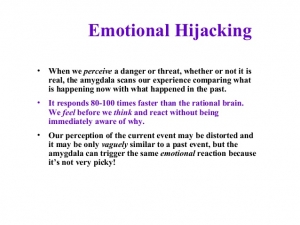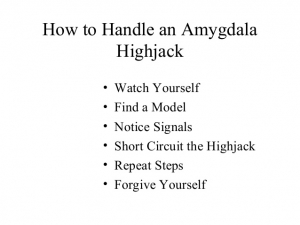Your anger may not be what you think it is!
|
|
The routes from sensation to action are depicted in this brain. The journey begins with sensation — in this case vision — which is routed to the thalamus. The thalamus acts as “air traffic controller” to keep the signals moving. In a typical situation, the thalamus directs the impulse to the cortex — in this case the visual cortex — for processing. The cortex “thinks” about the impulse and makes sense. “Aha,” it says, “this is an exclamation mark! It means I should get excited.” That signal is then sent to the amygdala where a flood of peptides and hormones are released to create emotion and action. |
In what Dan Goleman labeled “The Hijacking of the Amygdala,” the thalamus has a different reaction. Like any skilled air traffic controller, the thalamus can quickly react to potential threat. In that case, it bypasses the cortex — the thinking brain — and the signal goes straight to the amygdala. The amygdala can only react based on previously stored patterns. Sometimes this kind of reaction can save our lives. More frequently it leads us to say something harmful, to escalate the situation, or even to violence. To minimize the damage from hijacking, it is important to practice patterns which lead to de-escalation. From that hijacked state, that condition where your brain is flooded with electro-chemicals, you still have options. You do not need to stay hijacked — you still can choose actions. After all, the chemicals do not persist — they will dissipate in three to six seconds.
Pre-emotional hijack stage
In the pre emotional hijack stage, the biochemicals such as adrenaline are just beginning to kick in. There is still some ‘wriggle room’ to use stress management techniques and listen to the signals coming from your body in order to manage the angry response more effectively. At this stage self-awareness is critical because this is what enables the student to understand what their body is saying to them. If they pick these messages up they will be able to buy themselves time to keep the biochemical soup from becoming too concentrated. At this point they can use counting to 10, asking someone else for help, visualizing, humor and other methods that break the cycle. A complication at this stage is that the strategies they will have been using to try to deal with their other emotions will be coming under strain. For example:
- denial of particular feelings;
- acting-out behaviour which provokes responses in other people and creates so much furor that the original emotional stimulus can be ignored;
- oppositional defiance, which is a trademark of some young people, who find a way to deal with their feelings of impotence and uncertainty by opposing everything you say, do or stand for as a way to try to deal with what their feeling. These are not very effective strategies, although in the absence of concrete emotional competencies they are better than nothing! The emotion of the current situation will be activating these feelings too and so the size of the emotional hijack can be very much greater than the situation seems to call for. Teaching emotional competency as a standard part of the teaching day will gradually help students develop new ways to cope with the multitude of feelings they experience and make the pre emotional hijack stage less fraught after a while.
Post-emotional hijack stage
In the post-emotional hijack stage when the brain has become flooded with emotional charges, it is important to take at least 20 minutes to calm down before starting on any negotiation, reparation or other conflict management techniques. At this point, the important skills are active listening and empathy, after that comes conflict resolution.
|




Leave A Comment
You must be logged in to post a comment.